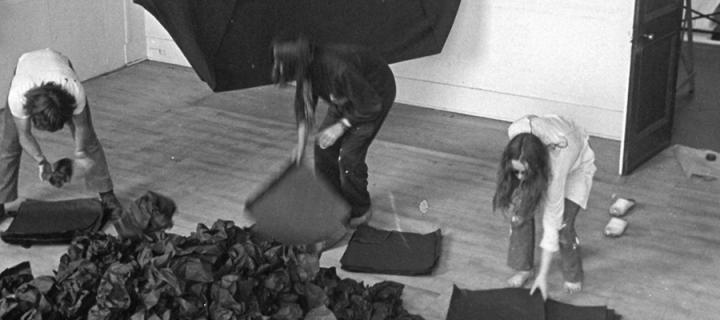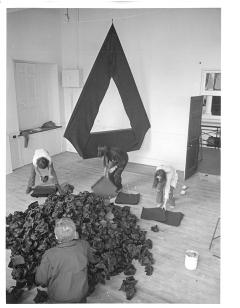14. Reiner Ruthenbeck’s ‘Highland’ installation being assembled by Ruthenbeck and ECA students in studio E.21
Reiner Ruthenbeck’s huge pile of crumpled paper, which he called a ‘Highland’, prompted the question ‘How is this art?’ for many who saw it.

Reiner Ruthenbeck (1937-2016) was a sculptor and conceptual artist, a contemporary of Gerhard Richter, Blinky Palermo, and Sigmar Polke.
Ruthenbeck was known for transforming space using unconventional materials like giant swathes of fabric and crumpled paper.
He began his career in the 1960s as a photographer, documenting performances and exhibitions by ZERO, Fluxus, and Joseph Beuys.
Indeed, he studied under Beuys in his sculpture class at the Kunstakademie Düsseldorf from 1962 to 1968.
A year before he participated in Strategy: Get Arts, Ruthenbeck was involved in the important group exhibition When Attitudes Become Form, curated by Harald Szeemann at the Kunsthalle Bern in 1969.
Ruthenbeck in situ with students
At SGA, Ruthenbeck, along with student assistants, would create a small mountainous pile of crumpled black paper on a studio floor, which he referred to as a ‘highland’. He was one of several artists at SGA, including Günther Uecker, keen to create an environment in situ.
The presence of these artists and the inspiration they gave to the student helpers and onlookers was partly what made SGA such an exciting event.
In discussion with Christian Weikop, SGA student helper Alexander Hamilton has said that Ruthenbeck’s ‘highland’ was one of the first works that somebody wanted to buy:
The principal dancer of the Netherland’s Dance Company was very keen to acquire it, but there was a strange conversation that he had with Ruthenbeck where he argued, ‘I need to have something on a piece of paper saying you will never make this work again.’ And Ruthenbeck said, ‘But it is only a pile of crumpled paper.’ There was an interesting debate about the nature of the art contract.

Ruthenbeck would participate in four documentas and presented work with Beuys and Jochen Gerz in the German pavilion at the 1976 Venice Biennale. His practice has continued to prompt the question ‘How is this art?’
From ECA to Serpentine
In 2014, he reprised his renowned 1971 installation, Overturned Furniture, this time at the Serpentine Gallery in London. It was first displayed at the Kabinett für aktuelle Kunst, Bremerhaven.
The initial inspiration for Ruthenbeck’s installation may well have come from Strategy: Get Arts (1970), and specifically Stefan Wewerka’s bentwood chairs ‘action’ on the main staircase of ECA.
Equally, Ruthenbeck may have been thinking of Brecht’s use of chairs in his sculptural installations, also seen at ECA.
At the Serpentine, the chairs were exhibited next to his signature pile of crumpled paper.
C.W.


